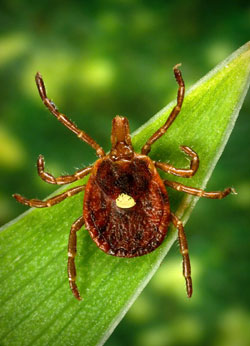Editor’s note: Looking for more motivation to get rid of bush honeysuckle? Or perhaps you’d like to tell your neighbors about the importance of removing invasive species? Judy Ward shared this article about a study done at Washington University.

Image from Centers for Disease Control, Public Health Image Library (PHIL)
WUSTL scientists says suburban influx of deer, invasive plants are affecting human health — from an article by Diana Lutz —
“You don’t have to go out into the woods anymore,” says tick expert Brian F. Allan, PhD, who just completed a postdoctoral appointment at Washington University in St. Louis. “The deer are bringing tick-borne disease to us.”
So, it stands to reason that anything deer like might increase the risk of tick-borne disease for people. The invasive plant bush honeysuckle, for example.
As Allan reports in his article, the density of whitetail deer in honeysuckle invaded areas was roughly five times that in areas without honeysuckle and the density of nymph ticks infected with bacteria that cause human disease was roughly 10 times higher.
In this part of the country, the tick of concern is Amblyomma americanum, called the lone star tick because the adult female has a white splotch on her back. The tick-borne diseases are the ehrlichioses, caused by bacteria in the genus Ehrlichia. “The lone star tick is very aggressive and will actually go after its host, running toward the host, faster than most people probably think a tick can run. It has sensory organs on its front two legs to detect your heat and your carbon dioxide signature homing in on your signal and when it gets really close, it grabs on.
Read the full article.

